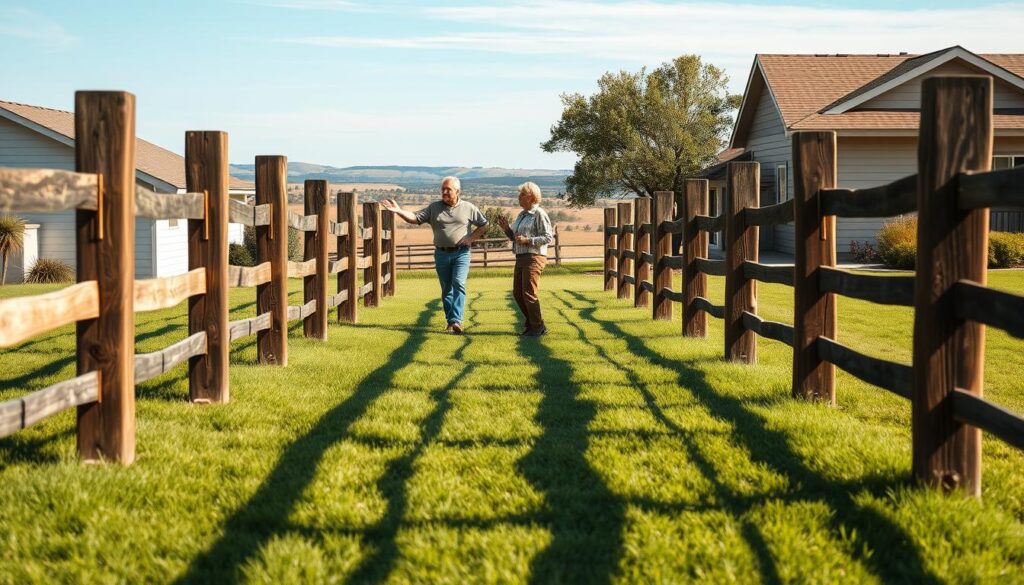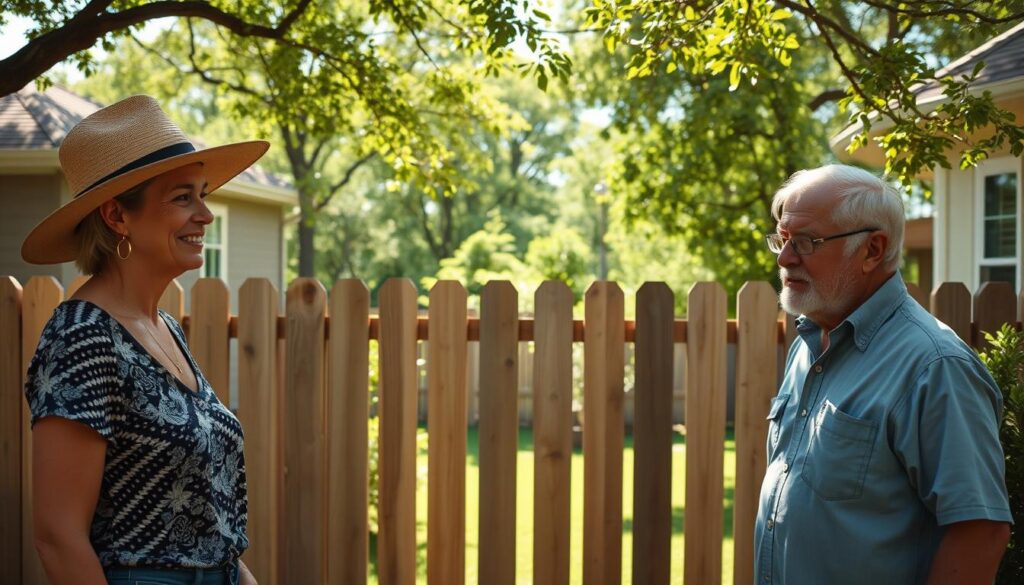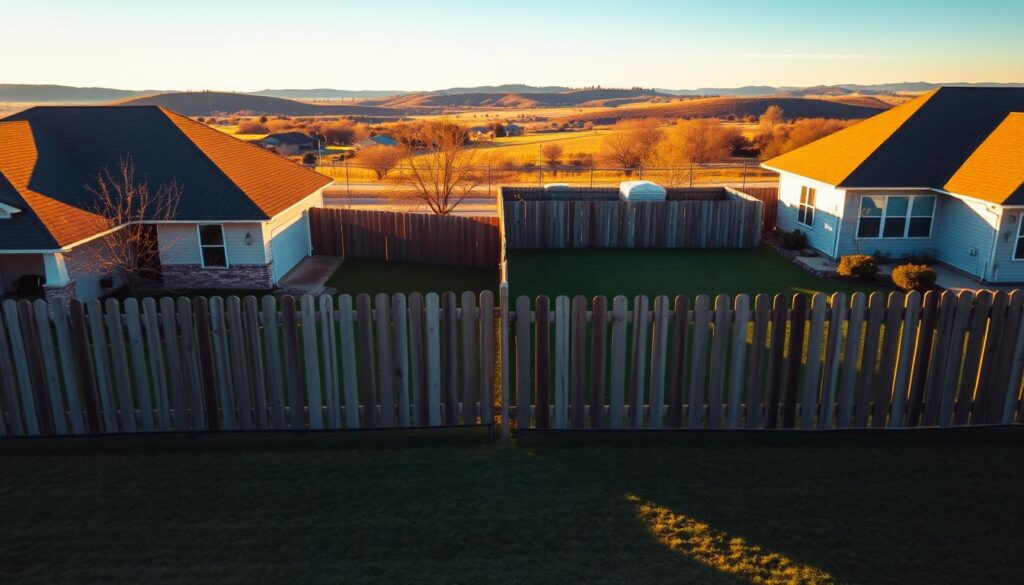Last updated on November 30th, 2025 at 06:57 am
Knowing Texas fence laws is key for homeowners to figure out who pays for a fence between neighbors. This can lead to disagreements. It’s important to look into local laws on fencing agreements and how costs should be split among the both of you.
You can handle any problems smoothly and work well with your neighbor.

Table of Contents
Understanding Texas Fence Laws
Texas fence laws help property owners know their rights and duties about fences. These rules are key for keeping good relations with neighbors. It’s important to understand these laws to avoid conflicts.
Key parts of these laws include:
- Definition of boundary lines: Knowing where your property ends is vital for fencing.
- Legal obligations for sharing costs: Texas law often makes neighbors share fence costs.
- Dispute resolution: Laws guide how to solve fence disagreements.
Learning about texas fence laws helps you handle issues and protect your property.

Importance of Fence Agreements
A fence agreement is key for clear roles and duties with your neighbor. It helps avoid misunderstandings by setting out who does what, like maintenance and costs. This way, you both know your responsibilities, preventing future problems.
Having a written agreement means you both have a clear plan. It helps solve disputes quickly and fairly. It also makes sure you both agree on who pays for repairs or changes.

In short, making fence agreements is wise for good neighbor relations. It tackles neighbor fence responsibility texas early, leading to a peaceful living space.
Who Pays for Fence Between Neighbors in Texas
Figuring out who pays for a fence between neighbors in Texas is about money and the law. Usually, both property owners must split the cost of shared fences unless they agree differently. It’s key for you and your neighbor to know these rules to live peacefully and avoid fights.
Legal Implications of Shared Fences
The laws about shared fences are very important. They say both neighbors should pay for the fence, showing they share the responsibility. If one neighbor wants to pay but the other doesn’t, going to court might be needed. Keeping records of all talks and agreements can help if there are any problems.
Determining Cost Responsibilities
Several things affect who pays for the fence. Think about why you need the fence, where it’s going, and any agreements before it’s built. If you both agree on why you need the fence, like for privacy, it helps figure out who pays. Talking about who will take care of maintenance costs is also smart, so you both know what’s expected.

Neighbor Fence Responsibility Texas
Knowing who is responsible for your fence in Texas is key to a good neighbor relationship. When fences are shared, both neighbors usually have to work together on upkeep. Regular checks and repairs are often needed. Talking things through can help avoid confusion about who does what.
Shared Maintenance Obligations
Both neighbors care about the fence’s condition. They might share duties like:
- Checking the fence for damage
- Working together on repairs
- Deciding how often to maintain it
Setting these rules helps keep things fair. It makes sure everyone knows their part in keeping the fence up.
Disputes Over Fence Costs
Cost disagreements can happen, like when repairs or new fences are needed. Problems can arise over who should pay or how much work is needed. To prevent fights:
- Talk openly about what you expect.
- Keep records of all agreements and work done.
- Think about mediation if talks get tough.
Handling these issues early can help keep things friendly. It reduces stress and keeps the peace.

Overview of the Texas Boundary Fence Act
The Texas Boundary Fence Act sets rules for building and caring for boundary fences. It makes it clear who is responsible for shared fences in Texas. A fence is considered a boundary fence if it crosses or is built right on the property line between two neighbors.
This act aims to improve how neighbors get along by outlining who pays for and maintains fences. It helps avoid disagreements by setting clear expectations for upkeep.
Both property owners must follow the act’s rules, making sure both sides care for the fence. Knowing the Texas Boundary Fence Act can help you protect your rights and work well with your neighbors. It ensures costs are split fairly and keeps legal problems away.

Texas Fence Negotiation Tips
When you negotiate a fence in Texas, good communication is key. It helps you and your neighbor understand each other better. Talking respectfully can start a good conversation about who pays and who does what.
Keeping the lines of communication open is important. It helps you both feel heard and understood. This way, you can work together better.
Effective Communication Strategies
Here are some tips for talking effectively during fence negotiations:
- Listen Actively: Showing you care about what your neighbor says can help calm things down.
- Be Clear and Concise: Make sure you say what you mean without confusion.
- Show Respect: Valuing your neighbor’s feelings can make things better.
- Remain Calm: Staying calm helps keep the conversation focused and less heated.
Creating Written Agreements
After you agree, it’s important to write it down. This protects both of you from future problems. Make sure your agreement includes:
- Cost Sharing: Clearly say how you’ll split the costs.
- Maintenance Responsibilities: Decide who will take care of the fence.
- Timeline: Set a deadline for when the fence will be done.
- Signatures: Have both of you sign to agree on the terms.
Common Fence Disputes in Texas
Fence disputes in Texas often come from different issues. One big problem is when neighbors disagree on property lines. They might not know where their land starts and ends, causing fights over fence placement.
Another common issue is what materials to use for the fence. Homeowners might have different tastes for looks and durability. This can lead to arguments if one person thinks the chosen materials don’t meet community standards.
Costs for building and keeping up the fence can also cause problems. Neighbors might argue over who should pay for it. This can lead to disagreements about who should cover the costs of building or maintaining the fence.
To deal with these fence disputes in Texas, talking openly with your neighbor is key. Understanding each other’s expectations can help reduce tension. It can also make working together easier.
| Type of Dispute | Description |
|---|---|
| Property Line Disagreements | Uncertainty about boundaries can lead to conflicts regarding where a fence should be erected. |
| Choice of Materials | Disputes may arise over differing preferences for fence materials, impacting appearance and durability. |
| Cost Sharing | Disagreements on how to split construction and maintenance costs can cause significant friction. |
Property Line Fence Texas: Key Considerations
Getting your property line right is key when putting up a fence in Texas. A clear boundary helps avoid fights with neighbors and keeps you in line with local laws. Knowing how to survey your property line can save you a lot of hassle and cash.
Surveying Your Property Line
Here are some ways to get your property line right:
- Hire a licensed land surveyor for a precise look at your property’s edges.
- Try GPS for a modern way to measure your property lines.
- Look at the county’s property records for details about your land.
- Use old surveys if you have them, as they can be helpful.
By doing these steps, you protect your rights and keep things friendly with your neighbors. It makes sure everyone knows where the line is.
Adhering to Local Ordinances
Following local rules and zoning laws is important for your fence. Before you start building, check these things:
- Local zoning laws that might control your fence’s height, material, and look.
- Homeowners Association (HOA) rules, if you have one, to avoid fines or penalties.
- If you need a permit to build a fence, your city or county might require it.
By sticking to these rules, your fence in Texas will last longer and look better. It also makes sure you’re following the law.
Understanding Texas Fence Rights
Knowing your rights about fences in Texas is key to keeping good relations with neighbors and protecting your property. In Texas, property owners have certain rights about fences. These rights affect boundaries and who is responsible for maintenance.
In other words, you have the right to improve it, repaint it, or cause repairs with respect to the fence. It is good to advise your neighbor beforehand about the work that you’re going to do with the fence so that both of you can agree on what is going to happen.
Another basic right that one has here is that one can remove or fix their fence. If the fence is damaged or needs repairs, then you can do that. However, you have to plan this with your neighbor to avoid misunderstandings. Ask your neighbor before you do it.
When sharing a fence with a neighbor, it is vital to be aware of your rights to preclude misunderstandings. Thus, gauging local and state law concerning property lines and respective fences could also be helpful. Such knowledge allows you to defend your rights while being neighborly.
Knowing your rights about fences in Texas gives you the confidence to deal with any issues. It makes sure you protect your property rights while being considerate of your neighbor’s space.
Texas Fence Repair Cost: What You Should Know
Knowing the texas fence repair cost is key for planning your budget. The cost can change a lot based on several things. These include the materials used, the labor, and how bad the damage is.
For example, fixing a wooden fence might cost differently than a vinyl or metal one. This is because each material has its own repair needs and prices.
Figuring out what you’ll spend can be easy if you look at common repair costs. For small fixes, you might just need to buy new parts. But for bigger problems, you’ll also have to pay for the work done.
In Texas, the cost for labor and materials can swing based on how serious the damage is. It’s smart to get quotes from several contractors to find a fair price.
Remember, the texas fence repair cost can depend on who owns the fence with you. Talking to your neighbor about fixing the fence can clear up who pays what. This can prevent any disagreements.
Bottom Line
Even if you run into problems with fence costs, knowing the Texas laws can help. Talking openly about boundaries and who does what is key. Having a written agreement can also make things easier and help everyone get along better.
Having a problem getting an offer for your house in Irving, TX; get an instant quote!
Understand your rights and duties, you can live better with your neighbors. Always try talking things out in person can lead to a better experience.
